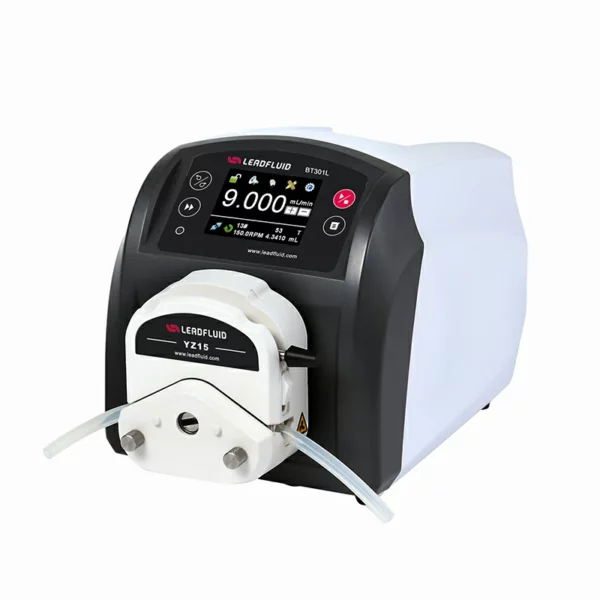The main difference between a high flow rate peristaltic pump and a low flow peristaltic pump lies in their respective capabilities to deliver fluid volumes at different rates.
Here are the key distinctions between the two:
- Flow Rate Range: A high flow rate peristaltic pump is designed to handle larger volumes of fluid and can deliver fluid at a relatively higher flow rate. These pumps are capable of delivering fluids in milliliters or even liters per minute. On the other hand, a low flow peristaltic pump is specifically designed for applications requiring smaller fluid volumes and operates at lower flow rates, typically in the range of microliters to milliliters per minute.
- Tubing Size and Configuration: High flow rate peristaltic pumps usually accommodate larger diameter tubing to facilitate the passage of larger volumes of fluid. The tubing used in these pumps is designed to handle the higher flow rates and pressures associated with delivering larger volumes. In contrast, low flow peristaltic pumps often use smaller diameter tubing, which allows for more precise and controlled delivery of smaller fluid volumes.
- Motor Power and Speed: High flow rate peristaltic pumps typically have more powerful motors to provide the necessary force for moving larger volumes of fluid through the tube. These pumps operate at higher motor speeds to achieve the desired flow rates. In contrast, low flow peristaltic pumps use lower motor speeds to enable more precise control over the flow rate, as smaller volumes of fluid require more accuracy.
- Applications: High flow rate peristaltic pumps are commonly used in applications that require the delivery of larger volumes of fluids, such as industrial processes, wastewater management, and large-scale liquid handling. They are also used in medical settings for tasks like blood transfusions or large-scale drug infusions. Low flow peristaltic pumps are more suitable for applications that require precise and controlled delivery of smaller volumes, such as laboratory experiments, chemical dosing, microfluidics, and medical devices that require accurate medication delivery.
It’s important to note that the definitions of “high flow rate” and “low flow rate” can vary depending on the specific context and industry. The distinction between the two types of peristaltic pumps is relative and depends on the intended application and the specific flow rate requirements of that application.
What are the benefits of high flow rate peristaltic pump?
High flow rate peristaltic pumps offer several benefits in various applications that require the delivery of larger volumes of fluid at relatively higher flow rates. Here are some advantages of using high flow rate peristaltic pumps:
- Efficient Fluid Transfer: High flow rate peristaltic pumps are designed to handle larger volumes of fluid, allowing for efficient and rapid transfer of fluids from one location to another. They can deliver fluids in milliliters or even liters per minute, enabling faster processes and reducing transfer times.
- Precise Control: Despite their high flow rates, modern high flow rate peristaltic pumps offer precise control over the flow rate and volume. They can be adjusted to deliver fluids at specific rates, allowing for accurate dosing and controlled delivery of fluids, which is crucial in applications that require precise control over the flow.
- Gentle Fluid Handling: Peristaltic pumps provide gentle fluid handling, as the fluid only comes into contact with the tubing. This is particularly important for delicate or sensitive fluids that need to be transferred without excessive turbulence, shearing, or contamination. High flow rate peristaltic pumps maintain the integrity and quality of the fluid being transferred.
- Versatility: High flow rate peristaltic pumps are versatile and can handle a wide range of fluids, including liquids of different viscosities, corrosive or abrasive fluids, and fluids containing suspended particles or sensitive biological samples. The pump tubing can be selected based on the specific application and fluid properties, ensuring compatibility and efficient operation.
- Sterile Pathway: Peristaltic pumps offer a sterile fluid pathway as the fluid only comes into contact with the tubing, which can be easily replaced or sterilized between uses. This makes high flow rate peristaltic pumps suitable for applications requiring aseptic or sterile fluid transfer, ensuring the purity and integrity of the fluid being delivered.
- Ease of Use and Maintenance: High flow rate peristaltic pumps are generally easy to use, with intuitive controls and user-friendly interfaces. They often have self-priming capabilities, eliminating the need for manual priming. The tubing is easily replaceable, and maintenance requirements are typically minimal, reducing downtime and operating costs.
- Compatibility with Automation: High flow rate peristaltic pumps can be integrated into automated systems and controlled by external devices or computer interfaces. This allows for seamless integration into larger processes and enables precise coordination with other equipment or instruments.
These benefits make high flow rate peristaltic pumps valuable in a range of industries and applications, including industrial processes, wastewater management, large-scale liquid handling, food and beverage production, and medical applications where the delivery of larger volumes of fluids is required.

